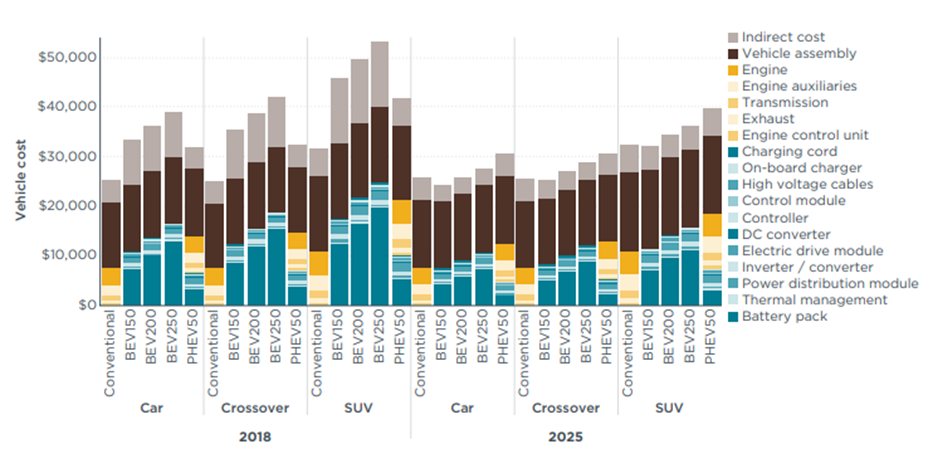Rural areas cover more than 70 percent of our country’s land area and are home to approximately 46 million people. If you live in a rural area, you probably have limited or no access to public transit, such as buses, shuttles or ride-sharing. Public transit in rural areas is limited by frequency of service, cost, long travel distances, and inadequate funding to address these limitations.
Rural residents therefore are more likely to depend solely on a private vehicle to get to work, school, medical appointments, shopping and other important destinations, so picking the right car or truck to drive is especially critical for rural households. All the factors that every driver normally needs to consider before buying a new vehicle – such as affordability, reliability, performance and fueling convenience – all take on special importance if you depend more on your vehicle than urban or suburban dwellers.
At the Union of Concerned Scientists, we’ve been looking into the benefits rural drivers could enjoy from switching from a gasoline vehicle to an electric vehicle. An earlier blogpost of mine took a first look at some of these benefits. We are also examining the barriers preventing drivers from making this switch and looking for avenues to address these challenges. In a recent survey, respondents in the United States who said they were not definitely planning to buy or lease an EV were asked which of a series of attributes would prevent them from doing so. The top three barriers were charging logistics (61% of respondents); range (55%); and the costs involved with buying, owning, and maintaining an EV (52%).
The lack of an accessible outlet to charge an EV at home is one such challenge faced by drivers when considering switching to an electric vehicle. In rural areas there are more people living in dwellings with a garage or driveway with an outlet, and therefore more drivers can charge at home with modest or perhaps no cost or logistics required. Public charging may be challenging anywhere, but more so in rural areas where utilization rates are low compared to other areas. Some states are addressing public charging in rural areas under the National EV Charging Infrastructure Program, a program from the Bipartisan Infrastructure Act that provides funding for public charging infrastructure. Another piece of good news is how the Inflation Reduction Act (IRA) extends the federal tax credit for charging equipment installation. It also revises the credit to require infrastructure be installed in low-income communities or non-urban areas.
Another common concern of rural residents has been the range and availability of electric vehicles. Today range is less of an issue, with improvements in lithium-ion batteries and many passenger EVs capable of powering up for 200 to 300 miles on a single charge, but slightly over half the respondents in the above-mentioned survey still claim it is a top concern.
Transportation costs in the U.S. are the second largest household expenditure after housing, and combined, transportation and housing costs account for approximately half of the average US household budget. Rural households spend a bigger share of their total purchases on vehicle purchases, fuel, insurance, maintenance and repairs, and finance charges.
Today I want to take a closer look at one of the most significant benefits from switching to an EV: fuel and maintenance savings. I will compare the upfront cost of switching to a new EV compared to the long-term savings for rural drivers when switching from gasoline to electricity.
The price difference is shrinking
Currently, the list price (or sticker price or Manufacturer’s Suggested Retail price) of a new EV is higher than a comparable gasoline vehicle. Estimating the average difference is quite complicated, as many factors are involved in the calculation. Car prices fluctuate based on demand and car dealer inventories. Many automakers have been developing luxury models before expanding to less expensive models, and averages often include luxury models, so these average differences can be significantly higher than the actual difference between a specific EV and a comparable gasoline car. A major factor in the final price is whether or not it is possible to apply the federal tax credits and the various consumer incentives available in many states.
The IRA changed requirements for new EVs to qualify for the tax credit. My colleague Dave Reichmuth summarizes these in his blogpost on what the IRA means for electric vehicles. The tax credit for a new EV is still up to $7,500, and there is now, for the first time, a tax credit of up to $4,000 for used EVs. A list of EVs that may meet the requirement for final assembly has been posted, but additional information will continue to be released.
Whichever way it is calculated, what really matters is that the difference between the upfront price of an EV and a gasoline vehicle is rapidly decreasing (first chart below). This downward trend in the cost of EVs is mainly because of declining battery costs. According to a study by The International Council on Clean Transportation (ICCT), assuming battery packs costs drop to $104/kWh in 2025 and $72/kWH in 2030, upfront price parity is likely to occur in 2024-2025 for passenger vehicles with shorter ranges and in 2026-2028 for those with longer ranges (second chart below).


As to availability, the EV market is expanding very quickly, with many automakers announcing plans to electrify large shares of their fleets. Rural residents who need larger vehicles may be interested to know that up to 100 EV models are planned for 2024, including SUVs and pick-up trucks. The electric version of the hugely popular Ford F-150 is already at some dealers.
Will rural drivers save on fuel and maintenance? Yes!
The initial expense still poses a barrier to many households, but the cost of EVs continue to decrease, Additionally, studies shows that the money you save switching to an EV makes up for the higher upfront cost of an electric car or truck regardless of where you buy your gasoline and where you would charge, and the savings are higher in rural areas. (here, here, here).
Why is this? Because savings from switching from a gas-powered vehicle to an EV depend on several factors, including the price of gasoline and the cost of your electricity, but also on two other very important factors.
The first factor has to do with the vehicle itself. EVs have much more efficient engines than gasoline vehicles. This difference is especially pronounced in rural areas, where vehicles tend to be larger and older. In Vermont, for instance, the average car in a rural area is 3 years older and 2 miles per gallon less efficient than in urban areas. In Virginia, 51% of vehicles in rural areas are older than 10 years, compared to 43% in urban and suburban areas. The older the car that you are upgrading, the greater the potential fuel savings will be.
Consider a car that covers 25 miles when it burns one gallon of gasoline. A typical EV that makes 3.15 miles/kWh will cover 106 miles from the equivalent energy contained in one gallon of gas (which is 33.7 kWh/gallon, in case you want this level of detail). In simple terms, EVs are at least 4 times as efficient as a gasoline vehicle. For less efficient larger and older cars, this difference in efficiency is even bigger.
The second factor affecting the overall cost of switching to an EV has to do with driving trends. People drive longer distances in rural areas, so savings per mile add up. Annually, across the country people drive an average of 13,500 miles in one year. In contrast, as an example, the average annual mileage for a rural household in Maryland is more than 25,000, almost twice as much as the national average.
Say you pay $3.485 for a gallon of gas, and $0.147 for a kWh, an example consistent with living in Maryland. And say you are thinking about switching from a typical gasoline car that makes 25 miles/gallon to a typical EV that makes 3.15 miles/kWh, as in the example above. This means you currently pay 14 cents per mile when you drive your gasoline car and you would pay 5 cents per mile to drive an EV. In other words, you save about three times driving an EV, for any number of miles. And a full-sized EV pickup truck also has the potential to save you about 50% more in fuel and maintenance compared to a mid-sized car.
Fuel and maintenance EV savings add up for rural drivers
But let’s keep going. If you now think about the annual fuel savings, assuming you drive 25,000 miles per year, you spend $3,485 on your gasoline car ($0.14/mile x 25,000 miles) and would spend $1,163 in your new EV ($0.05/mile x 25,000 miles). That adds up to fuel savings of about $2,322 in one year. Of course these numbers change along with the price of gasoline and electricity, and with the distance you travel.
According to a study, in Vermont over the lifetime of an average vehicle, fuel and maintenance savings add up to almost $27,000 for rural households versus less than $22,000 for urban ones.
If gasoline prices continue to be high, savings could be even larger (these estimates from Vermont assumed EIA gasoline price forecasts, which projected lower prices than the high ones we have today). In West Virginia, assuming a driver who logs in 14,000 miles annually (about 38 miles daily), annual fuel savings jumped from under $1,000 in 2019 to $1,800 recently because of higher gasoline prices. Being protected from the volatility of the price of gas is another benefit in most locations in the U.S. As we have seen from recent world events, this is not a minor consideration. As to the volatility of electricity prices, Texans last year did see huge price spikes in their energy bills, but Texas has an isolated power grid and is unique when it comes to the regulation of energy markets. My colleague, Mark Specht addressed this in a blogpost.
Over time, fuel and maintenance savings compensate for the initial price difference between a gas-powered car and a comparable EV, even before factoring in consumer incentives. The current upfront difference is easily offset by the long-term savings, and this difference will only decline with each year that goes by.
So if you live in a rural area and are considering buying a new or used vehicle, check out a few electric options before you make up your mind.

